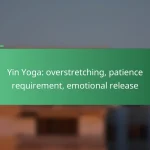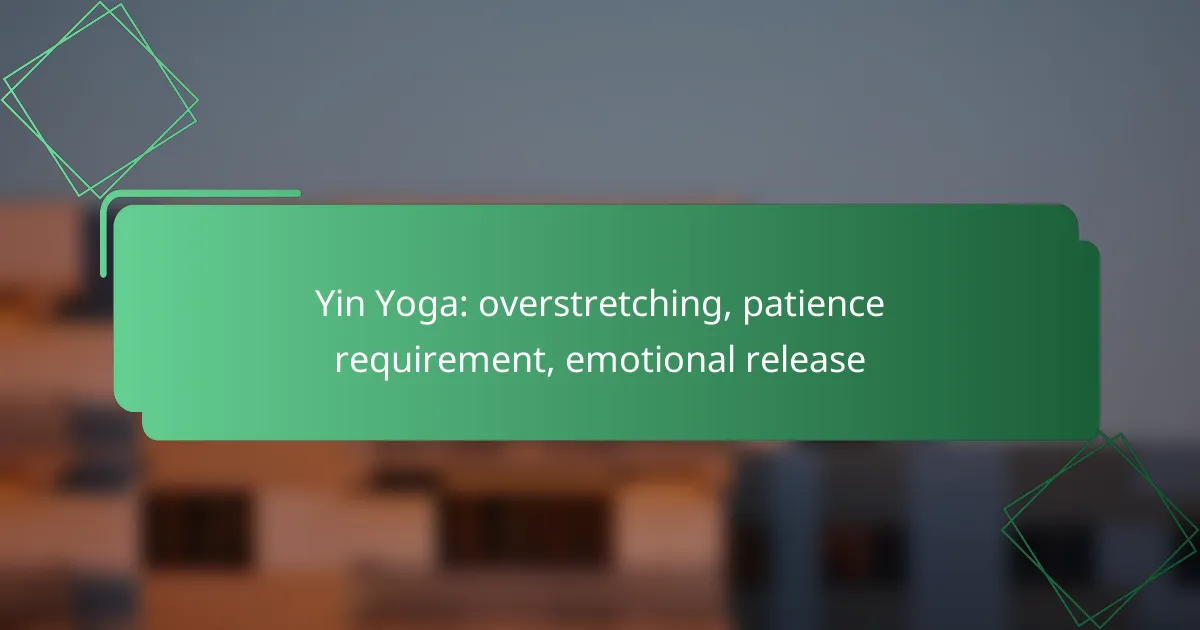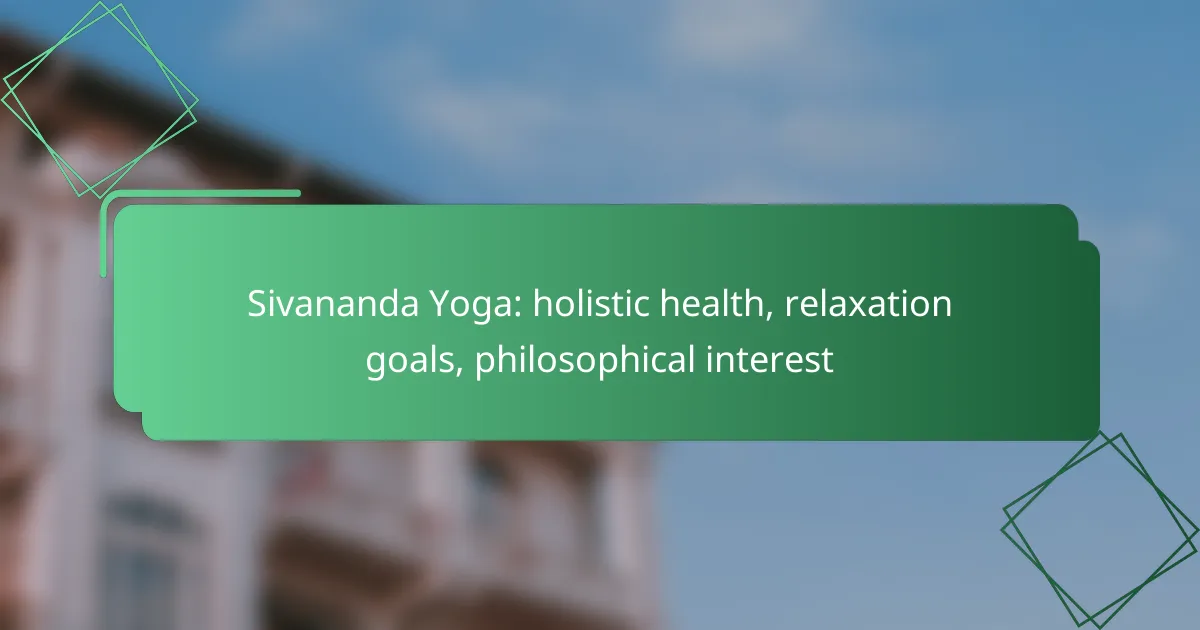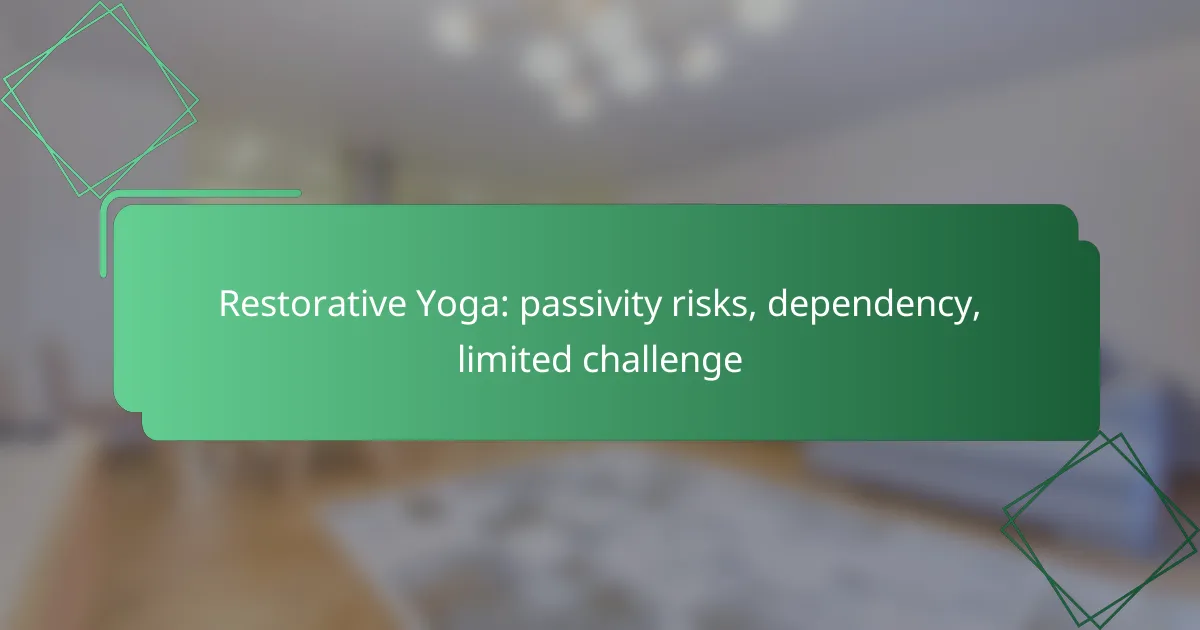Vinyasa Yoga offers a dynamic practice that can be both invigorating and challenging, especially for beginners. The fast pace of classes may present difficulties, such as maintaining balance and flexibility, while also navigating transitions between poses. To minimize the risk of joint strain, newcomers should focus on proper alignment, use props for support, and gradually progress in their practice.

What are the best Vinyasa Yoga practices for beginners?
For beginners, the best Vinyasa Yoga practices focus on gentle flow sequences, modified poses, and breath control. These elements help ease newcomers into the practice while minimizing the risk of injury and joint strain.
Gentle flow sequences
Gentle flow sequences are ideal for beginners as they allow for a gradual introduction to Vinyasa Yoga. These sequences typically involve slower transitions between poses, which helps build strength and flexibility without overwhelming the body.
Common gentle flow sequences may include poses like Cat-Cow, Downward Dog, and Child’s Pose. Practicing these flows can enhance body awareness and prepare beginners for more dynamic movements in the future.
Modified poses for accessibility
Modified poses are crucial for making Vinyasa Yoga accessible to all beginners, especially those with limited flexibility or joint issues. Using props such as blocks, straps, or bolsters can help support the body and facilitate proper alignment.
For example, instead of a full Forward Fold, beginners can bend their knees and place their hands on blocks. This modification reduces strain on the lower back and encourages a more comfortable practice.
Focus on breath control
Focusing on breath control is essential in Vinyasa Yoga, as it helps synchronize movement with breath. Beginners should practice inhaling and exhaling deeply, using the breath to guide their transitions between poses.
Incorporating techniques such as Ujjayi breath can enhance the practice by promoting relaxation and concentration. Beginners should aim to maintain a steady breath throughout their practice to avoid unnecessary tension and improve overall flow.
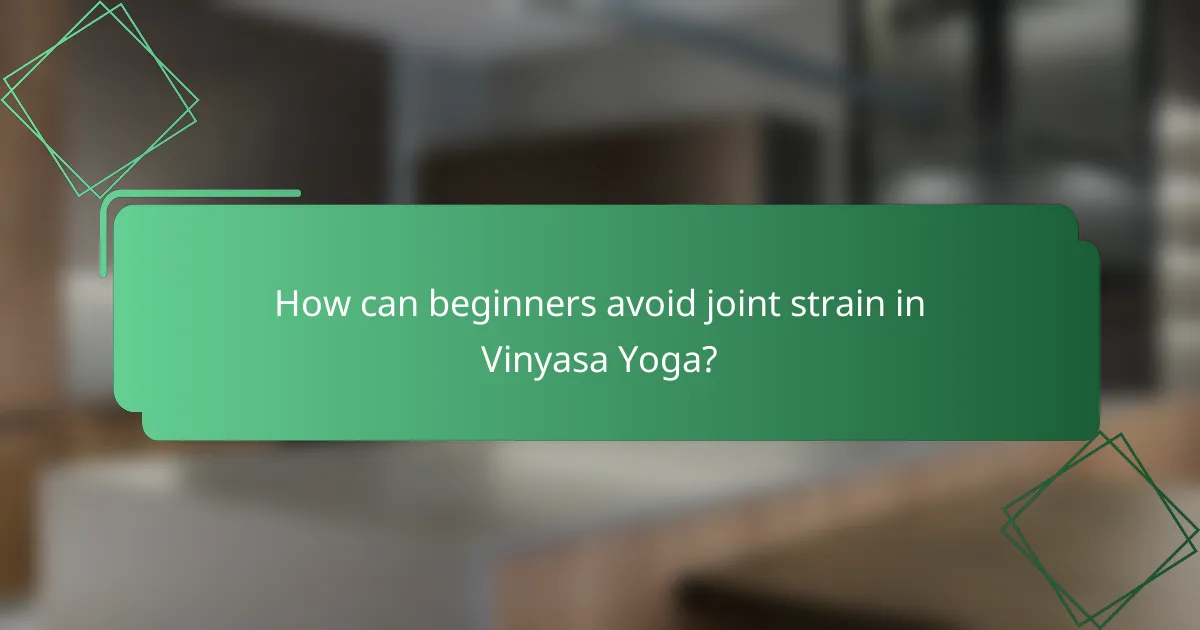
How can beginners avoid joint strain in Vinyasa Yoga?
Beginners can avoid joint strain in Vinyasa Yoga by focusing on proper alignment, utilizing props for support, and progressing gradually in their practice. These strategies help ensure that movements are safe and effective, reducing the risk of injury.
Proper alignment techniques
Maintaining proper alignment is crucial in Vinyasa Yoga to prevent joint strain. Beginners should pay attention to body positioning, ensuring that joints are stacked correctly and that weight is distributed evenly. For example, in downward-facing dog, the wrists should be aligned with the shoulders and the hips should be lifted to avoid compressing the lower back.
Using mirrors or practicing in front of a wall can help beginners visualize their alignment. Additionally, seeking feedback from instructors can provide valuable insights into maintaining correct posture throughout various poses.
Use of props for support
Props such as blocks, straps, and bolsters can significantly enhance stability and support in Vinyasa Yoga. Beginners should not hesitate to use these tools to modify poses and make them more accessible. For instance, placing a block under the hands in a forward fold can alleviate strain on the shoulders and lower back.
Incorporating props allows practitioners to focus on alignment without overextending their joints. This approach can lead to a deeper understanding of each pose while minimizing the risk of injury.
Gradual progression in practice
Gradual progression is essential for beginners to build strength and flexibility safely in Vinyasa Yoga. Starting with foundational poses and slowly incorporating more complex sequences helps the body adapt without excessive strain on the joints. It’s advisable to practice consistently but to limit sessions to a manageable duration, such as 30 to 60 minutes, to avoid fatigue.
Listening to the body is key; if discomfort arises, it’s important to modify or skip certain poses. Beginners should aim to progress at their own pace, ensuring they master basic techniques before advancing to more challenging variations.
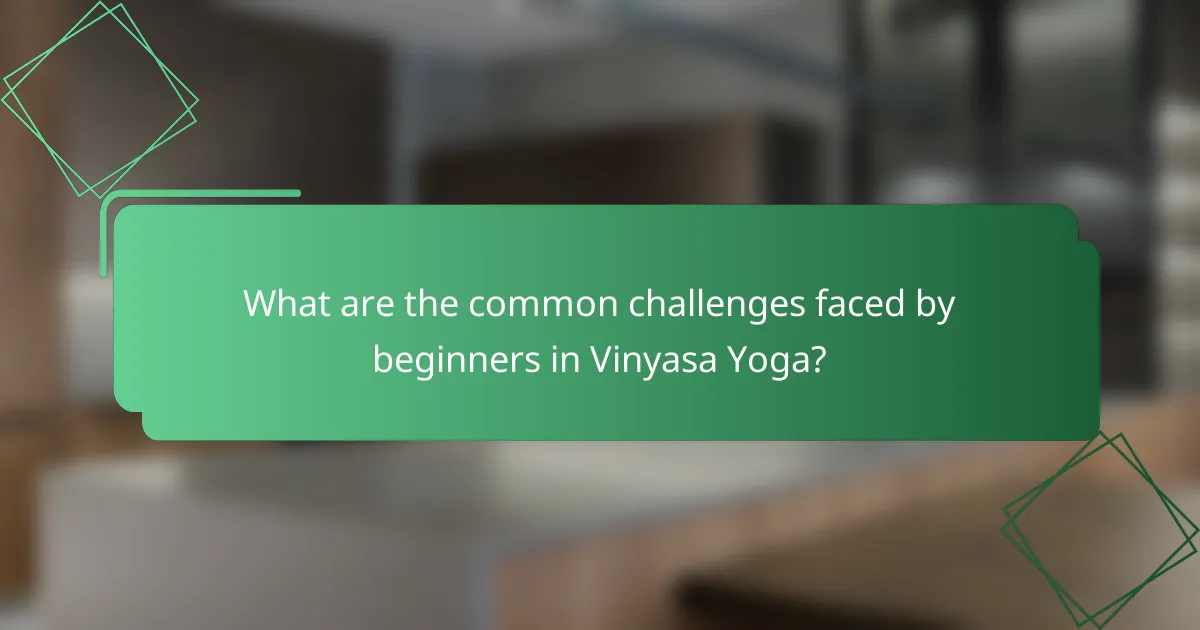
What are the common challenges faced by beginners in Vinyasa Yoga?
Beginners in Vinyasa Yoga often encounter several challenges that can hinder their practice. These include difficulties with the fast pace of classes, struggles with balance and flexibility, and understanding the transitions between poses.
Difficulty keeping up with pace
The fast pace of Vinyasa Yoga can be overwhelming for beginners, as classes often flow quickly from one pose to another. This rapid transition can lead to frustration and a feeling of being left behind. To manage this, beginners should focus on their breath and take modifications when necessary.
It’s beneficial to practice at home with online videos or slower classes to build confidence. Beginners should remember that it’s perfectly acceptable to pause and regroup during a session, allowing them to maintain their form and avoid injury.
Struggles with balance and flexibility
Many beginners find that their balance and flexibility are not yet developed enough for certain poses in Vinyasa Yoga. This can make it challenging to hold poses or transition smoothly. To improve, beginners should incorporate specific stretches and balance exercises into their routine.
Practicing foundational poses like Tree Pose or Warrior III can help enhance stability. Additionally, using props such as blocks or straps can provide support and make poses more accessible, gradually building strength and flexibility over time.
Understanding transitions between poses
Transitions between poses in Vinyasa Yoga are crucial for maintaining flow and rhythm. Beginners may struggle to understand how to move from one pose to another seamlessly. To ease this process, it’s helpful to break down transitions into manageable steps.
Practicing common transitions, such as moving from Downward Dog to Plank, can help solidify understanding. Beginners should take their time to learn these movements, focusing on alignment and breath, which will enhance their overall practice and confidence in class.

What are the benefits of Vinyasa Yoga for joint health?
Vinyasa Yoga offers several benefits for joint health, primarily through its focus on fluid movement and breath synchronization. This practice can enhance flexibility, strengthen muscles around the joints, and improve overall mobility, making it a valuable option for those looking to support their joint function.
Improved flexibility
Vinyasa Yoga promotes improved flexibility by encouraging a range of motion in various poses. Regular practice can help lengthen muscles and connective tissues, reducing stiffness and enhancing overall joint function. For beginners, starting with gentle flows can gradually increase flexibility without overwhelming the body.
To maximize flexibility gains, focus on poses that target specific areas, such as downward dog for the hamstrings and pigeon pose for the hips. Aim for sessions of 30-60 minutes, several times a week, to notice significant improvements.
Strengthening surrounding muscles
Strengthening the muscles surrounding joints is crucial for joint health, and Vinyasa Yoga effectively addresses this through dynamic movements. By engaging in various poses, practitioners build strength in key muscle groups that support the joints, such as the quadriceps, hamstrings, and core muscles.
Incorporate poses like chair pose and warrior sequences to enhance muscle strength. Focus on maintaining proper alignment to avoid strain and ensure that the muscles are effectively engaged during each movement.
Enhanced joint mobility
Enhanced joint mobility is a significant benefit of Vinyasa Yoga, as the continuous flow of poses encourages the joints to move through their full range of motion. This practice helps lubricate the joints and can reduce the risk of injuries associated with stiffness.
To improve joint mobility, include poses that involve rotation and extension, such as spinal twists and lunges. Consistency is key; practicing regularly can lead to noticeable improvements in how freely your joints move.

How to choose the right Vinyasa Yoga class?
Choosing the right Vinyasa Yoga class involves considering factors like the instructor’s experience, class size, and whether the class is suitable for beginners. These elements can significantly impact your practice and overall experience.
Instructor experience and style
When selecting a Vinyasa Yoga class, the instructor’s experience and teaching style are crucial. Look for instructors with certifications from recognized yoga schools and those who have a solid background in Vinyasa techniques. A good instructor should be able to adapt poses to accommodate different skill levels and provide modifications for beginners.
Additionally, consider the instructor’s teaching style. Some may emphasize alignment and safety, while others focus on flow and creativity. Attend a trial class if possible to gauge how well their style matches your preferences.
Class size and environment
The size of the class can greatly affect your learning experience in Vinyasa Yoga. Smaller classes often allow for more personalized attention and adjustments from the instructor, which can be beneficial for beginners. Aim for classes with fewer than 15 participants if you prefer a more intimate setting.
Also, consider the environment of the studio. A calm, welcoming atmosphere with good ventilation and appropriate temperature can enhance your practice. Check for cleanliness and the availability of necessary props like blocks and straps to support your poses.
Focus on beginner-friendly classes
For those new to Vinyasa Yoga, seeking beginner-friendly classes is essential. These classes typically focus on foundational poses and basic breathing techniques, making them less overwhelming. Look for classes labeled as “beginner” or “level 1” to ensure the pace and content are suitable for your experience level.
Additionally, many studios offer introductory packages or workshops specifically designed for beginners. These can provide a supportive learning environment and help you build confidence before progressing to more advanced classes.


